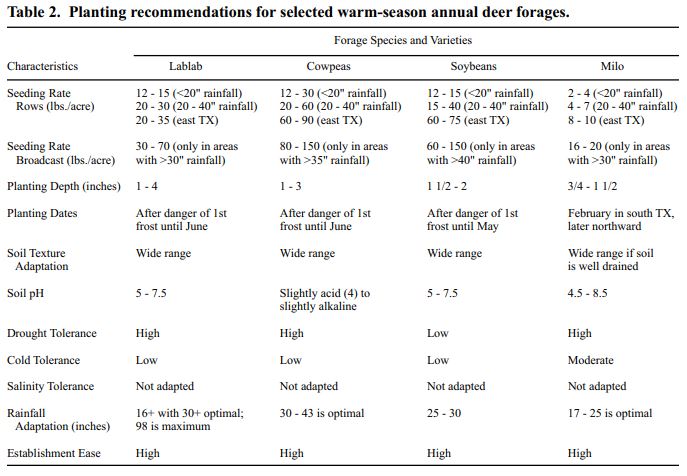Deer Food Plots as Supplemental Feed for Deer Management
The two habitat variables that affect deer diets and nutrition are plant availability (quantity and accessibility) and quality (nutrient content and digestibility). Native plants vary in abundance, stage of growth, and nutritional characteristics on a seasonal basis. Because of this variation, a common practice in white-tailed deer management is the development and maintenance of deer food plots.
The best fit for food plots is to supplement forage provided by native habitat. However, some managers attempt to use food plots to increase the deer carrying capacity of a whitetail herd. Is this a good idea? Not always.
Are Deer Food Plots Right For You?
Deer management is about habitat management and using high-quality native plants to meet the nutritional requirements of deer. As most land managers are aware, producing quality whitetail means enhancing and maintaining high-quality deer habitat that provides both food and cover. That said, the biggest struggle in most deer management programs is to harvest enough deer to keep the herd in check with the available habitat.
Some deer managers want to have lots of deer. That almost always means an inflated deer population. Here enters a case for supplemental feeding and deer food plots. These are both viable ways to increase available forage for white-tailed deer depending on the situation. These are merely supplements though. Supplemental products, whether through feed or food plots, are not replacements for healthy plant communities. Deer thrive when native plants are diverse and in found in abundance.
Pros & Cons of Deer Food Plots
Food plots are great as supplemental food for white-tailed deer—if they grow. In the southeastern part of the United States, because of ample rainfall, deer food plots make a lot of sense. In areas, such as some parts of Texas, where rainfall can vary or fall off sharply, food plots don’t always work. This can pose a problem for a deer management program. It’s best not to rely on plot to keep a deer herd going strong if the risk of failure is high.
In these cases, it is recommended that the property owners look at providing supplemental protein pellets rather than food plots. Why gamble the time and money on a deer food plot in low-rainfall areas? Protein pellets will provide supplemental nutrition without a hitch.
Spring & Winter Deer Food Plots
When it comes to food plots for deer, cool season (winter) food plots are generally more reliable than warm season (spring) food plots. Cool season species are not susceptible to drought or weed competition in most cases. This is not the case with warm season plantings. One exception may be legumes, which may require delayed planting if rainfall is deficient in the early fall months of September and October.
It is recommended that cool season species be planted on either upland or bottomland sites. The reasons are because of cooler temperatures and increased water availability during fall and winter periods.

Cool season species planted to winter food plots commonly consist of oats, wheat, rye, arrowleaf clover, sweet clover, subterranean clover, Austrian winter peas, and brassicas. Various companies provide a myriad of cool season seed mixes that combine a number of plants into a single food plot mix. These are often good choices because of the variety of seeds in the mix; at least some of the species will work with the soil types found on your property.
Spring food plot species are much more reliable when planted in bottomland soils that retain moisture during the drier summer months. However, care should be taken to select a food plot site that is not prone to flooding from nearby streams, rivers, or other waterways. Dry, upland soils are not good sites for warm season species for obvious reasons. Avoid such areas and concentrate spring food plots on the better soils on a property when possible.
Warm season species selected for deer food plots should be selected for their ability to grow quickly and compete with native weeds. Remember, with either warm or cool season supplemental forages, soil samples should be taken to determine lime and fertilizer requirements. Failure to properly prepare the soil may result in drastically reduced yield or excessive weed competition. If you are going to do it—do it right!

Deer Food Plots: One Part of Deer Management
Well planned deer food plots can increase forage availability and at least partially compensate for lower quality deer habitat. However, maximum benefits are obtained if forages planted into plots complement the diet available from native vegetation. This means planted forages in deer food plots are available when native vegetation is lacking or is low in nutritional value.
There is an immediate satisfaction when a planted deer plot grows as planned, but evaluating its necessity is important. Take a good, hard look at your deer management program. Only then you can decide if food plots for deer and other wildlife are right for your program. This will ensure the time, money, and space used on your property is a good investment.